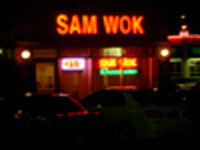
Chinese food and cooking has influenced the cuisines of so many cultures around the world today. It should be no surprise therefore that Chinese food can be found in almost any country on earth. In Canada, for example, this influence can be seen in any city's Yellow Pages- listing more restaurants advertising Chinese food than food from any other region of the world (including pizza!). In North America, Chinese food has also recently spawned a new brand of cooking called "Asian Fusion", combining cooking styles of the Far East with ingredients and flavours of the West.
The Chinese philosophy of food emphasizes three things: freshness, flavour, and texture. If the ingredients to begin with are of poor quality, so too will be the final product. Much flavour is achieved by using a variety of regional spices, blended and cooked at very high temperatures. The central provinces of Sichuan and Hunan (where I was born) have the spiciest food in all of China. Garlic, chilies, and ginger are staples to most dishes in the region. Of course, there are many other regional variations in Chinese cuisine. Cantonese cuisine, of the south, is heavy on fish and seafood; while northern Peking cuisine includes more meat. Pork is most common meat in all Chinese dishes. Different texture layers are given to each dish by purposely selecting ingredients that are unlike one another in consistency, but complement each other in flavor. Also, dishes can be topped with raw foods such as peanuts, to achieve crunchiness, or vegetables for moisture and freshness.
Chinese cooking is not complicated in comparison to many European nations. Much less depends on temperatures of ingredients and exact cooking times. Chinese dishes are most often just cooked in water or oil. Chinese meals are always accompanied with tea (a major national export) and meals are capped off with fruit (usually cool orange slices) or, on special occasions, specialty desserts like moon cakes.
Sam Wok is THE quintessential late-night-Chinese-place in Old Strathcona. Open till 4am on most nights, it hosts the most interesting clientele at around 2am on a Friday night as area nightclubs empty hundreds of hungry, intoxicated revelers onto city streets. Prices are fair, portions are large, but the quality could be better.

Late-night neon lights outside Sam Wok at 1am.
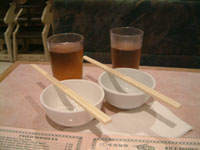
At a Chinese restaurant, anytime is tea-time!

Jarome wondering why his order is taking so long.
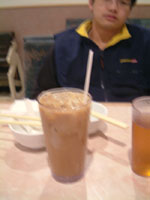
My Hong Kong iced coffee arrives first.
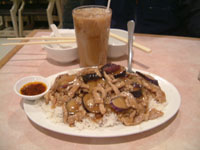
To complete my combo, eggplant with shredded pork on rice. $6.25

Jarome beginning to get annoyed at the service.
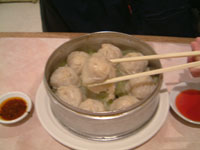
35 minutes later (after I've finished my dish), Jarome's dim-sum breakfast dish arrives.
The place to go for cheap food, if you don't mind the wait and questionable cleanliness.
University of Alberta Restaurant Review
Rob's Edmonton Restaurant Review
InfoEdmonton.com Restaurant Guide
MyTravelGuide.com Edmonton Restaurant Review
Frommer's Edmonton Restaurant Guide
RealEats.com Alberta Restaurant Review
Last updated: April 14, 2005